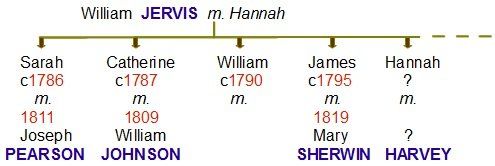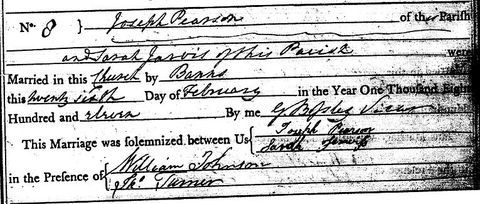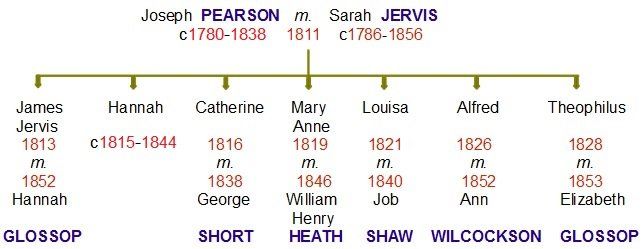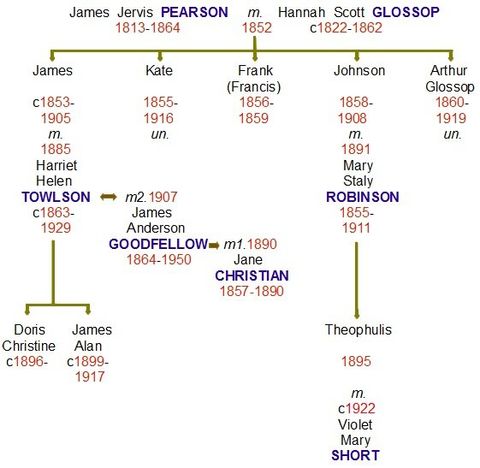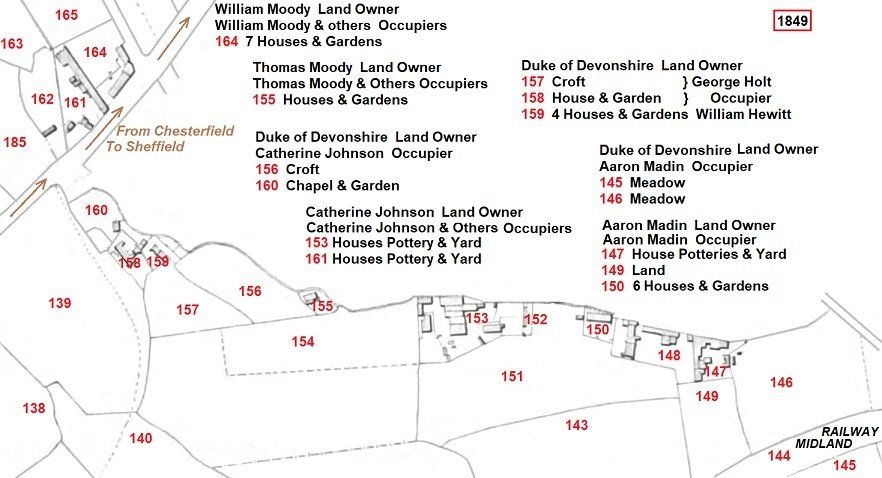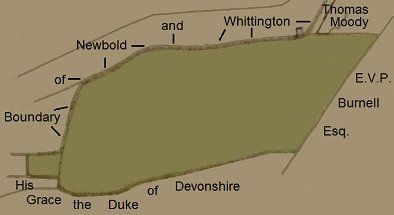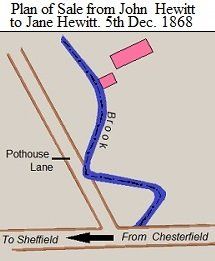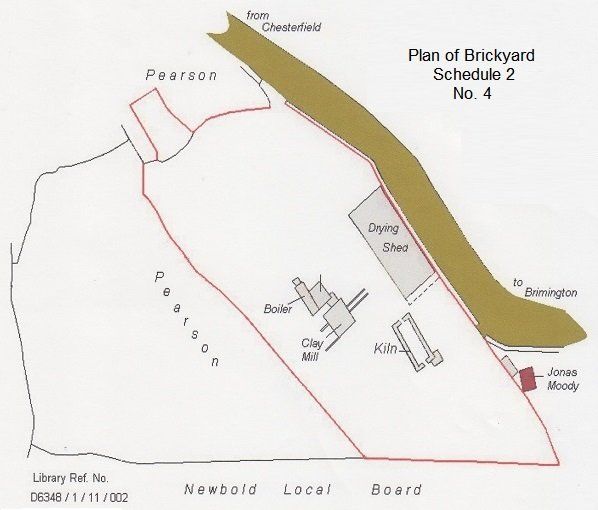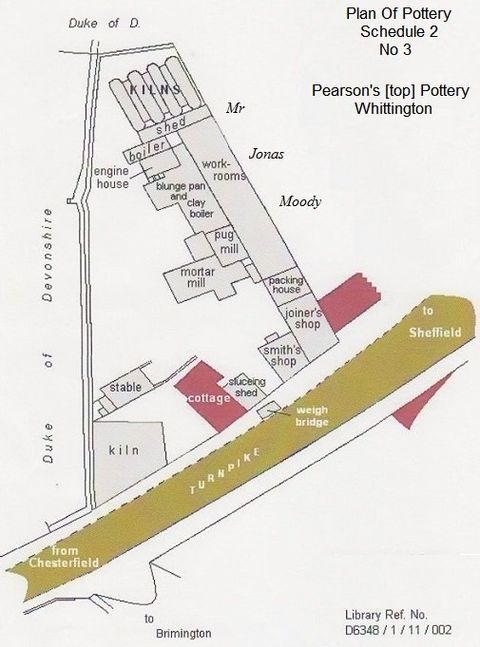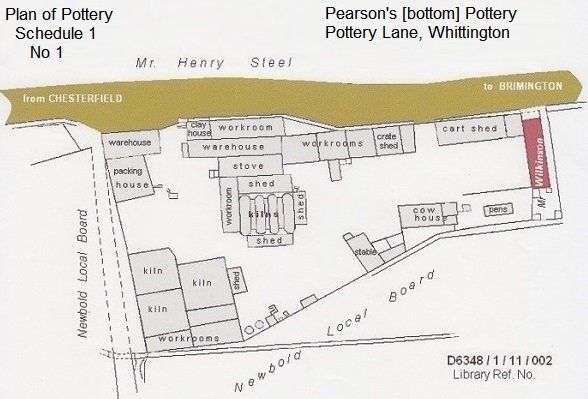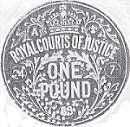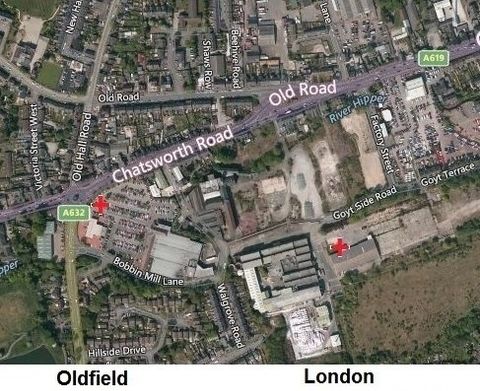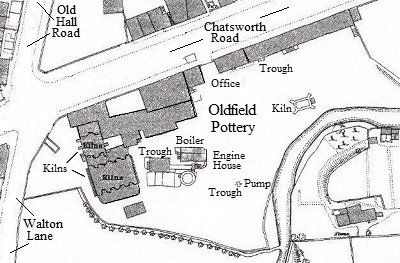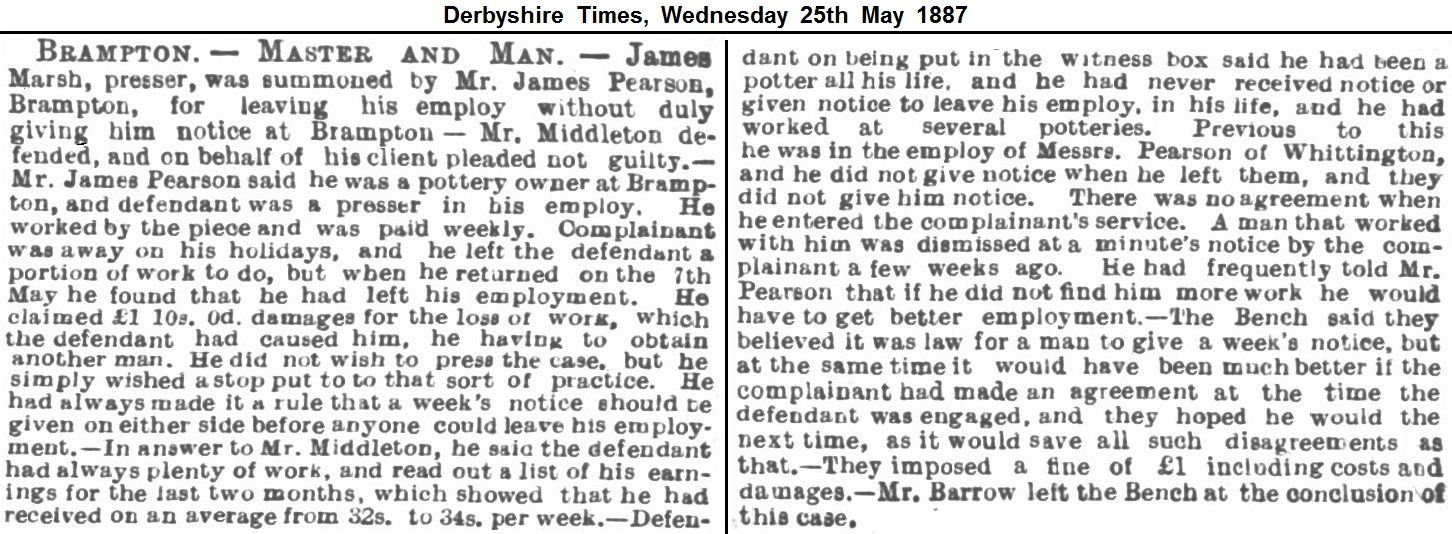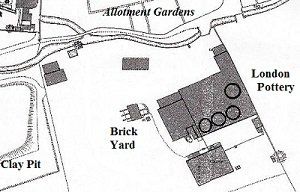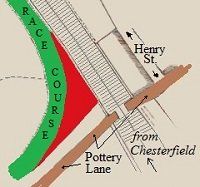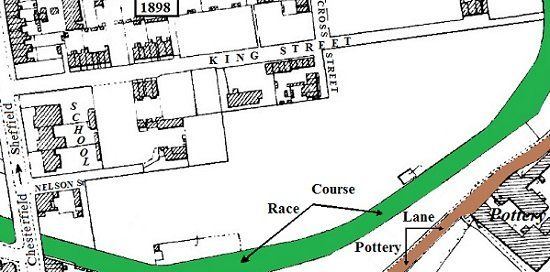It was the dissolving of the partnership, (above), which led to the selling of the pottery that William Johnson then bought. [Bottom Pottery]
Pearson Potteries 1810 - 1898Brampton & Whittington
A blog about the Pearson Potteries. I've broken it up into sections for an easier read.
A quick summary: The beginning of the Pearson Potteries: Two daughters of William & Hannah JERVIS, of Yorkshire, married William JOHNSON & Joseph PEARSON, respectively.
William & Catherine [nee Jervis] JOHNSON had no heirs that I found; but Joseph & Sarah [nee Jervis] PEARSON, had 7 children [that I am aware of].
When William died he left his property to his wife Catherine with the suggestion that she should leave the business to her nephew James Jervis PEARSON, eldest son of Sarah & Joseph, when she died - if he helped her run it when she lived.
Catherine died & she left the business to James Jervis PEARSON. When James Jervis PEARSON died he left his estate in Trust for his children; his brother Theophulis PEARSON & friend John REED being the Trustees. The Trust realized in 1881 & with it came a family bust up over the inheritance. It was the start of there being 2 Pearson Potteries - the Whittington ones run by Theophulis, (brother of James Jervis Pearson), & a few members of the family; & the Brampton ones run by James, the son of James Jervis Pearson.
The Families:
The Morning Post, London, 9th September 1807
PARTNERSHIP DISSOLVED
"..... Samuel Sanforth, William Wass, and William Jarvase, at Whittington Moor Pottery, Derby."
Derby Gazette 8th September 1807
"Partnership dissolved between Samuel Sanforth, William Wass & William Jarvase; manufacturers earthenware pots, Whittington Moor Pottery near Chesterfield."
Pigot's Directory of 1822-23 has William Johnson as an earthenware manufacturer; & the later White's Directory of 1833 as an earthenware manufacturer & brown & stone bottles, both at Whittington Moor.
Joseph Pearson was a miner in Matlock Bath when his son James Jervis was baptised in 1813; but then he went on to be a hatter, being in Pigot's Directory of 1828/29; & living at Matlock Green when his other children were baptised in 1834 at Matlock.
James continued to work for Catherine & help her in the business. At the time of the 1841 Census Catherine was an Earthenware Maker & James was the manager; on the 1st of April 1845 they both borrowed £700 from William Jebb for business purposes. Catherine was still the owner of the pottery in January 1846:
Derby Mercury Wednesday 17th December 1845 John Fells of Stonegravels committed to Derby County Gaol.
Derby Mercury 14th January 1846
STEALING AT CHESTERFIELD
John Fells, aged 29, was charged with having, on the 11th day of December, at the parish of Chesterfield, feloniously stolen forty-seven pounds of weight in coal, the property of Catherine Johnson.- Prosecutrix manufactures pots at Chesterfield, and her nephew Theophulis Pearson, saw prisoner steal the piece of coal which formed the subject of the indictment, and witness's brother followed him and took it out of his apron.-Guilty.-One month hard labour.
By the 1851 Census Catherine was a Retired Earthenware Manufacturer & living at Springvale, Hasland. Sarah, with sons James Jervis, Alfred & Theophilus were living on Sheffield Rd. Chesterfield, her daughters, Catherine, Louisa & Mary Ann having married. (See 'Pearson Family'
page for more details). James was then an Earthenware Manufacturer employing 45 males & 20 females. Both Alfred & Theophilus were assisting in the pottery.
Catherine Johnson died on Wednesday 21st July 1852, whilst taking a holiday in Blackpool, Lancashire. She'd taken her favourite niece Catherine Short (eldest married daughter of Sarah Pearson), with her; & there was a family / legal argument, which came about upon the death of Catherine Johnson, regarding her gold watch & chain.
According to Catherine Short, whilst Catherine Johnson was on her death-bed she asked her aunt if she would give her her gold watch & chain to remember her by. Her aunt said yes so Catherine took it. As James Jervis Pearson was the sole executor of Catherine Johnson's Will & heir to all of Catherine's Real & Personal Estate he took George Short, Catherine's husband, to court to recover the said gold watch & chain. He said that as Catherine Johnson had not personally handed over the watch & chain then it had not been given to Catherine - so it was not a gift. The judge sided with James Pearson & said that the gift was not good. Catherine Johnson had not personally handed over the watch & chain & as the request was made when Catherine was so poorly she probably wouldn't have had her faculties about her. The jury returned a verdict for James Pearson. £12 for the watch, £1 10s for the chain & 1s in damages.
On the 4th September 1852 Alfred Pearson married Ann Wilcockson; on the 2nd October 1852 James Jervis Pearson married Hannah Scott Glossop, daughter of Isaac Glossop, Maltster, in Chiswick, Middlesex; & in 1853 Theophulis married Elizabeth Glossop, Hannah's sister. Sarah Pearson died 2 November 1856 having seen all her children married.
James left a Will, dated
7th September 1864, in which he left his estate in trust for his children.
His brother Theophulis & friend, John Reed, earthenware manufacturer of Mosboro, Yks. were the executors & guardians of the children & the estate.
James mentions, as part of the estate, 2 potteries & all the buildings that go with the trade, a brickyard, Meadow Croft shops, land in Brampton & Newbold, a colliery, farming stock & implements, household goods & furniture & any other real & personal estate.
Theophilus was to act as manager with a wage of 56 shillings a week; & he & John Reed were to keep the businesses going or enhance them. If a business became unprofitable then they could sell it, or sell items of the estate that weren't connected to the business if money was needed. Monies not exceeding £50 per child should be used for the benefit of James' children for maintenance & education.
When James' youngest son, Arthur Glossop reached 21 yrs, on 23rd February 1881, then an appraisement should be made of the estate & it would go to the children, with a share for Theo. - if he had managed the businesses. He also goes on about who receives what if a member or members of the family dies. If no-one dies then his daughter, Kate, will receive one quarter of the estate; the rest is to be divided between his sons James, Johnson & Arthur, & brother Theophilus.
The 1871 Census shows that Theo. & his wife Elizabeth were living on Pottery Lane with their, now 4, children & the 4 children of his brother James J. Pearson. Theo. is an Earthenware Manufacturer, coal owner, Blacksmith & Carpenter, employing 90 people.
1875 sees Theo. buying land & property on Pottery Lane. He buys property, (except mines & minerals underneath), for a total of £859 10s., from the Duke of Devonshire.
In the Green:
No. 157 --- 3 roods, 15 perches, messuage & garden.
No. 158 --- 23 perches, messuage & garden in the occupation of Henry Holt.
No. 159 --- 26 perches, croft, stack yard, cowhouses & piggary.
No. 159a --21 perches, messuage, yard, garden & piggary, occupied by Mathew Wright.
No. 160 --- 1 rood 9 perches occupied by Isaac Hewitt.
In the Pink: No. 1 - 21 perches No. 2 - 20 perches,
No. 3 -14 perches No. 4 - 9 perches
All in the occupation of Isaac Hewitt.
Jane Hewitt, widow, owned the land & buildings marked in the center of the plan.
Trouble between employees; & a case of trespassing...
Derbyshire Times Wednesday 2nd October 1878
POLICE INTELLIGENCE.
CHESTERFIELD COUNTY POLICE, SATURDAY.
ASSAULT AT WHITTINGTON MOOR.- Betsy Smithard, summoned by Ellen Neale, for assaulting her at Newbold, on Monday morning Sept. 23rd.- Both complainant & defendant are employed by Mr. Theo. Pearson at his potteries on Whittington Moor; & during the time allowed for breakfast it seems that defendant accused complainant of being in company of her
(defendant's) husband several times during the previous Saturday afternoon & night, after which it was alleged a blow was struck by defendant, Ellen Neale. Several witnesses were called for both sides & the magitrates dismissed the case.
TRESPASSING IN PURSUIT OF GAME.- Theo. Pearson charged Geo. Hardy & Geo. Hunter with trespassing in pursuit of game at Whittington on the evening of September 17th.- Mr Pearson had previously requested them not to go on to his land, but he (Mr. Pearson) had lately been annoyed more than ever by this party.
They were seen about 100 yards off the footpath going up the hedge-side each defendant having a dog; eventually a rabbit was "put up" & one of the dogs caught & killed it.- Mr. Cutts who appeared for the defense contended that both defendants were on the footpath, & the dogs seeing a rabbit, followed it & killed it before they could be called back. A man who lives near the field was called for the prosecution, & he stated he saw defendants in the field mentioned quite 100 yards from the path, beating the hedge, & when the dog which had killed the rabbit came up the field with it, he got hold of the rabbit & showed it to Mr. Pearson.- The bench imposed a penalty of 5s. & costs.
The Census of 3rd April 1881 shows Theo., his wife Elizabeth & their children Tom, Annie & Theo. jnr. together with his late brother, James Jervis Pearson's, 4 children, James, Kate, Johnson & Arthur Glossop, living in Abercrombie Street, Chesterfield.
Theo. snr. is a Brick, Stone & Bottle Manufacturer & Coal Owner, employing 124 men. His son Theo. is a General Assistant at the Works; Tom is an Assistant Chemist; & Frank is away at school. His nephew James is the Manager at the pottery; Arthur an Assistant at Works & Johnson is a Civil Engineer.
On the 23rd February 1881 Arthur Glossop Pearson, James J. Pearson's youngest son, reached the age of 21 years: This was when - according to James' Will - an appraisement & valuation of the businesses & land etc would be made; & his children would benefit from the Trust set up by their father & receive shares. Kate would receive one quarter then the rest would be shared equally between his 3 sons & his brother Theo.
Between the time the 'Deed of Gift' was signed in July 1881, & mid 1883, James Pearson changed his mind about giving up his share of the businesses, & decided to take his uncle to court, to set aside the Deed & receive his share of the Trust. He believed his uncle had used monies far beyond that he was entitled to.
Then came more court cases which must have caused upset for the family, & the emergence of 2 Pearson Pottery Businesses - one at Whittington owned by Theo. snr., Theo. jnr., Johnson & Arthur Glossop Pearson, & one at Brampton owned by James Pearson.
So began the court cases of James v. his uncle Theophilus
Derbyshire Times Saturday 28th July 1883 Theophilus Pearson v. James Pearson
"A CHESTERFIELD POTTERY CASE
PEARSON v. PEARSON
In the High Court of Justice, Chancery Division, on Thursday, before Mr. Justice Kay, Mr. Hastings Q.C. on behalf of plaintiff, moved for the appointment of a receiver and manager of a pottery business carried on near Chesterfield. The parties were partners, the plaintiff holding thirteen sixteenths of the business, whilst the defendant only held three sixteenths, and as the business was not so profitable now as formerly, owing to a variety of circumstances, the plaintiff was anxious to have a receiver appointed until some definite arrangement could be come to, plaintiff being willing for a dissolution of partnership to take place."
Mr. Joseph Saunders [sic] who had been in the employment of the firm for over 25 years was appointed interim receiver & manager. No decision about the dissolution of the partnership was discussed.
Derbyshire Times Saturday 24th November 1883 James Pearson v. Theophilus Pearson
In the High Court Chancery Division, London, before Mr. Justice Kay, Mr W. Pearson Q.C. & Mr Baker was for the plaintiff, James Pearson, & Mr. Graham Hastings Q.C. & Mr. Mulligan for the defendant, Theophilus Pearson, to decide a permanent receiver & manager.
Mr Pearson Q.C. stated that James Jervis Pearson, who had carried on business as a potter, died, leaving 4 children, & 2 actions were pending bearing on the administration of the estate which included a brickyard & land at Brampton. Joseph Saunderson [sic] was appointed interim manager & receiver. James thought Mr Sanderson was not the proper man as he was employed at the works, & he allowed all letters to go to the house of the defendant Theophilus Pearson. He asked for the appointment of Septimus Short, accountant, as manager.
Action was denied as it was thought any stranger acting as manager might seem to imply financial difficulty in the business, & might cause it harm. Mr. Sanderson was appointed manager.
Derbyshire Times Saturday 23rd February 1884
The Agreement
LOCAL LAW CASE. CHANCERY DIVISION
PEARSON v. PEARSON
Before Mr. Justice Kay on Friday. Mr. Baker on behalf of the plaintiff, James Pearson, applied for an order to be made for inquiries into the books & accounts of Theophilus Pearson. The defendant's father, James Jervis Pearson, died in 1864 & by his directions left his brother Theo. Pearson to carry on the business until 1881, when the youngest child came of age. The plaintiff, James Pearson, & the other children then made a deed of gift of the business to the defendant, & also gave him release from the Trust.
From certain facts which had come to the knowledge of plaintiff, he now wished to set aside that deed. He alleged that since the death of the testator the defendant had made use of money for himself far beyond what he was entitled to, & plaintiff wanted the Court to order enquiries, to help him prove allegations. The other children, however, confirmed the deeds of gift & release.
Justice Kay said the deed was binding until it was shown otherwise. The testator's estate was not sufficient to pay the debts & the business had been the creation of Theophulis Pearson. The applicant must establish breach of trust, he could not order an enquiry.
On Thursday 27th March 1884
an agreement was made between Theophulis Pearson & James Pearson. The High Court ordered the following: [summarized]
**
Following an agreement made by the two parties, Theophulis would pay James £1,500, to go with the £500 already
paid to him, for his shares in the business
**
James releases Theo. from all claims on the business & properties.
**
Theo. indemnifies James against all existing liabilities.
**
Nothing in the agreement, "shall be deemed to restrict or prevent the said James Pearson from carrying on and exercising the trade or business of potter or earthenware manufacturer or any other business at such a place as he may think fit and under the name of 'James Pearson'"
**
Theo. will discontinue carrying on business under the name of 'James Pearson' & will send out a circular telling customers on or before the 3rd April 1884.
**
All letters addressed to James Pearson 'Chesterfield' or 'Whittington Moor' shall for a period of 2 months be sent to Theo. Pearson, then after that to James Pearson.
**
The completion of the purchase should take place on the 17th April 1884 & if delayed interest will be paid.
**
Each party pays their own costs; & James will not pay any part of the costs for having a receiver & manager.
**
Joseph Sanderson, the receiver & manager, appointed 23rd November 1883 will be discharged.
It was in 1884 that James Pearson tried to buy the Beehive Pottery at Brampton:
Derbyshire Times 14th March 1885
At a court hearing in the Chesterfield County Court: Pearson v. Glossop:........ "Mr Gosling, owner of the Beehive Pottery, Brampton said that last year" [1884] "plaintiff" [James Pearson] "was in negotiation with him for purchasing the pottery but the negotiations fell through......"
Derby Mercury 2nd April 1884
HIGH COURT, CHANCERY DIVISION, PEARSON v. PEARSON
Mr. Mulligan for the plaintiff, Theophulis Pearson, stated it had been arranged that James Pearson sold his share of the business for £2,000 to his uncle, & the consent of the Court was asked to the stay of all further proceedings in the action. Consent given.
Derbyshire Times Wednesday 23rd April 1884 Summary Theo. Pearson v. James Pearson
HIGH COURT, CHANCERY DIVISION.
Mr. Robinson Q.C. & Mr. Mulligan for the plaintiff, Theophulis Pearson & Mr. Graham Hastings Q.C. & Mr. Baker for the defendant, James Pearson. Mr. Robinson said there was an interim injunction that had expired that day which he wanted to extend until the next hearing of Thursday week. His clerk had made a mistake in dates. The motion was to restrain James Pearson from soliciting certain customers of the old firm of 'James Pearson' of Whittington Moor Pottery, & of opening letters addressed to either 'James Pearson Whittington Moor', Chesterfield, or 'James Pearson' Chesterfield.
The Order was extended but Mr. Robinson was to pay costs because of the mistake.
Derbyshire Times Saturday 3rd May 1884 Summary - 2 motions Pearson v. Pearson
Before Mr. Justice Kay in the Chancery Division of the High Court, two motions.
One was on behalf of James Pearson, of Brampton, to ask that Theophulis Pearson be restrained from sending by post or otherwise issuing or circulating a letter or circular signed Theophulis Pearson, dated April 1884, or any other letter of circular containing an untrue representation of the proceedings in this action, which took place in this Court on the 9th April 1884, & that he may be committed to prison for contempt of this. James was represented by Mr. Hastings Q.C.
The other motion was on behalf of Theophulis Pearson, of the potteries, Whittington Moor, Chesterfield, to restrain James Pearson from opening letters addressed to the Whittington Moor firm, & from soliciting the customers of the said business. Theo. was represented by Mr. Robinson Q.C.
Mr. Hastings produced several affidavits to prove that the issuing of the circular, by Theo. Pearson, was calculated to do James Pearson irreparable injury, & that when the 'ex parte' order was earlier obtained, his Lordship expressly intimated that no such circular be issued. Theo. had not represented what had happened in court fairly & it was impossible to know who had read the circular & then resolved not to send any more orders to James Pearson & had gone elsewhere.
Mr. Justice Kay said that the course adopted by Theo. Pearson was highly improper.
Mr. Robinson said that when 'ex parte' injunctions were obtained then circulars should not be sent round, but before the court decided he must ask his Lordship to hear the other side. He then went on to say that James Pearson had agreed that all letters, for a period of 2 months after he left the firm, should go to Theo. Pearson. He then gave dates of when James had allegedly received letters that should have gone to Theo.; & that Theo. had posted a letter from Liverpool which James received also. He also said James Pearson had sent round a circular to customers of the firm stating that his connection to the firm had ceased after working for 15 years in management, & that he had started his own business, "and having every requisite appliance he did not hesitate to solicit a continuance of the favours granted to the late firm, and hoped that the great attention which had secured their support in the past might continue to be exerted on their behalf in the future." The circular was sent round within a month of James leaving. Attached to the complaint also, but not specifically stated, was the fact that James Pearson had taken a large quantity of letter paper & envelopes which he sent to customers - the only difference was that he'd put a line through 'Whittington Moor'.
Mr. Hastings then read an affidavit by James Pearson saying the letter from Liverpool was sent to entrap him & he returned it to the post office, & all the letters addressed to him during the 2 months in dispute, were kept at the post office in a box. There was also an affidavit by Mr. G. E. Whomersley, a post office official of Chesterfield, who said that James Pearson had called in & rented a box for all letters addressed to 'James Pearson' be put in.
Mr. Justice Kay said that James Pearson had shown all the letters he said he received & that there was no breach of the interim injunction. He found that the motion that James had received letters was "not true" & had been "absolutely
disproved".
Mr Robinson then said that that part of the motion wasn't as important as the solicitation of customers of the old firm by James; & the circular Theo. sent out was not contempt of court but he had acted under very great provocation. Theo. wouldn't do it again & he would pay the costs & apologise to the court.
Mr. Justice Kay found that although James could set up business where he thinks fit & in the name of 'James
Pearson', an injunction would be granted to stop James from sending out other circulars & also not soliciting any person who was a customer of the old firm prior to March 27th 1882, privately, by letter, traveller etc.
Derbyshire Mercury 16th July 1884
An appeal made so that James Pearson could solicit privately, personally or by traveller, customers that were previously customers of his uncle; & could also send out circulars for his business - although he was not appealing against the restraint of the circular he had previously sent out.
Previous Judgement overturned & James Pearson was given permission.
James begins building his business at Brampton.
James buys the Oldfield Pottery, Brampton. summaraized
Sale of John Oldfield's Estate LOT 12
All those pottery kiln ovens, offices, outbuildings, shed, ware-houses, yards etc. situate at the junction of the main road leading from Chesterfield to Chatsworth, with an extensive frontage to the Chesterfield & Chatsworth road in Brampton, containing an admeasurement 1 acre & 33 perches.
A successful earthenware manufactory business has been carried on continuously on the above premises for nearly 100 years.
The Midland Railway have a siding within 5 minutes of this place. The premises are in the occupation of the vendors, & are sold as a going concern, the business to be carried on under the direction of the Court.
Products: Oldfield Pottery: Jewitt's 'Ceramic Art of Great Britain' 1800-1900
Brown ware: dishes & bowls of various kinds; turtle, beef, butter, dutch, stew. Sauce & other pots; bottles & jars, of all shapes & sizes; pitchers & jugs in all shapes & sizes; churns; milkpans & pancheons; tea & coffee pots; Welsh trays; carriage & feet warmers; hare-pins & dog troughs; spirit & wine barrels & kegs; figured flower pots & stands; scent jars; 'hunting', 'cottage', 'tulip' & other figured jugs & mugs, etc. of "great beauty & design", & other articles.
It wasn't plain sailing though...
Fire at Oldfield Pottery
The previous Saturday about 3 am a fire was reported at Oldfield Pottery: Sergeant Nicholls & some constables were despatched from Chesterfield with the curricle engine. Upon arriving they found nothing could be done except to prevent the fire spreading. They managed to do that & at 6 am returned to Chesterfield.
"The building is known in the trade as the dry ware stove, in which was a number of pots in the process of drying before being burnt, and above this was a store room which contained a large quantity of pots and jugs. All these and the building in question were destroyed, and there now remains the bare walls and some charred beams. Fortunately the brigade were able to obtain a good supply of water from the main, or the fire may have resulted much more seriously. We understand the property is insured but in what office we have been unable to ascertain."
Meanwhile the Whittington Potteries were expanding:
The Newbold & District Local Board sold a piece of land, which was a part of a close called the 'Broad Meadow', to the Whittington Potteries ie Theo. snr., Theo. jnr., Johnson & Arthur Glossop Pearson on
4th October 1886.
The land contained about 38 1/2 perches & is
coloured in
Pink. The price was £100 & didn't include mines & minerals which were reserved to the Sheepbridge Coal & Iron Company Limited.
Derbyshire Times Saturday 28th May 1887 Death of Theophulis Pearson Summary
Theophulis Pearson died suddenly on Sunday the 22nd May 1887 at his residence in Abercrombie Street. The funeral took place in the burial ground attached to the Unitarian Chapel on Wednesday afternoon. In his Will he left monies to his wife Elizabeth, niece Kate, daughter Annie Jervis, nephew Johnson & sons Tom & Frank Pearson. He left the business in equal shares to his son Theophulis & nephew Arthur Glossop Pearson as tenants in common. If one of them wants out of the business then the other gets first refusal of the shares.
James is putting his foot down over employees working notice, so he won't be left in the lurch. It's not the best thing to happen when you're building up your business.
Derbyshire Times Saturday 2nd July 1887 James is making a go of his business at Brampton & expanding
WANTED a number of YOUTHS, (over 18 years of age), to make jars, night shift from 6 pm to 5.30 am; no previous knowledge required, piece work.
Apply James Pearson, pottery Brampton.
Derbyshire Times Wednesday 30th May 1888
GRAVEL for GARDEN WALKS, a supply of Clean, Sharp, Gravel always on hand at Pearson's Pottery, near Tram Terminus, Brampton. Price 1s 6d per ton.
The
1891 Census brings Elizabeth Pearson, widow of Theo., as head of the family at 24 Abercrombie Street, Chesterfield: With her is her niece Kate, daughter Annie, son Theophulis Pearson (Earthenware Manufacturer), nephew Arthur (Earthenware Manufacturer) & nephew Johnson Pearson (Mining Engineer). Elizabeth's son Tom is a Chemist Manager in Ramsgate, London; & her son Frank is a Veterinary Student in Midlothian, Scotland. All are unmarried.
Johnson Pearson later marries Mary Staley Robinson, daughter of William Bradbury Robinson, on
12th September 1891 at St. Thomas, Brampton.
James Pearson, his wife Harriet, & mother in law Christiana Towlson, are living in the Manor House, Brampton.
On the 24th August 1894 Theo. Pearson bought 4 pieces of land from George Waterhouse, a butcher of Whittington Moor, for the sum of £335. Theo. later sold it to Messrs. Pearson & Co.
I do not
have a plan to go with the text in the document but I have a part of a map from
1898 which will give you an idea.
“….. All that piece of land situate at Whittington Moor........ containing be recent admeasurement four thousand two hundred square yards or thereabouts.....and..... is bounded on the East side by the Chesterfield Racecourse and on the North by King Street to which it has a frontage of one hundred and fifty yards or thereabouts.
Also all that close of land situate at Whittington Moor..... and bounded on the South East side by the said Racecourse and containing in the whole three acres or ten perches or thereabouts....
Also all that other piece of land situate in Whittington Moor.....containing two thousand eight hundred and twenty square yards or thereabouts and bounded on the North side by Nelson Street to which it has a frontage of sixty yards or thereabouts....
Also all that other piece of land situate at Whittington Moor..... containing one thousand six hundred and seventy square yards or thereabouts and adjoining the said Racecourse and bounded on the North side by Nelson Street aforesaid to which it has a frontage of thirty four yards or thereabouts.
Subject nevertheless.... to full right and liberty of the owner or owners..... of the land and hereditaments of the West side of the piece of land lastly hereinbefore described..... [they and their families/agents on foot or using a vehicle of any sort can travel] on along and over the private road forming part of the piece of land lastly ….. described and situate on the West side thereof ….. and which is of the uniform width of fifteen feet and which said private road leads into Nelson Street aforesaid..... And also the right for..... Theophulis Pearson his heirs..... [he & his family/agents etc can travel] in along and over King Street, Nelson Street and Cross Street aforesaid and any other other (if any) adjacent streets leading to & into the Turnpike Road leading from Chesterfield to Sheffield.....”
Derbyshire Times Saturday 1st June 1895
James is in trouble under the Factory Act. [Summary]
A case under the Factory Act was heard at the Chesterfield Borough Court on Thursday. The prosecutor was Commander Smith, H.M.L., of Sheffield & the defendant was Mr. James Pearson, Oldfield pottery owner, Brampton. The case was heard by Alderman Dr. George Booth & Mr. James Haslam.
The charge was that Mr. Pearson committed a breach of the 3rd section of the Factory & Workshops Act 1878, by employing three young persons, Charles Mason, Leonard Walker & Winfield Turner, after hours during which they could be engaged at the pottery.
On Saturday the boys should be employed from 6 or 7 in the morning until 2 o'clock in the afternoon. On Saturday 4th May assistant inspector Mr. F.J. Parkes, visited the pottery & the boys were working & it was passed 2 pm.
Mr. Pearson said his manager had told him the boys were making up for lost time because because they had been idle & the stuff they were using would've been spoiled if they had left it.
The bench fined Mr. Pearson 1s & 12s 6d costs in each case.
On the
12th October 1897 Theo. sold 4 pieces of land to Messrs. Pearson & Co., Whittington potteries for £335. He had previously bought the land from George Waterhouse, a butcher of Whittington Moor, for the same price. [see above]
Derbyshire Times Wednesday 19th October 1898
Fire at Whittington Moor Pottery
An outbreak of fire was discovered about 9 o'clock on Sunday morning at Messrs. Pearson's pottery works on Pottery Lane, Whittington Moor. The roof timbering had become over-heated. Plenty of assistance being at hand, a portion of the roof was cut away, & the burning part was isolated & speedily put out. The Fire Brigade from Chesterfield arrived on the scene after the flames had been subdued. The amount of damage is only slight.
Continued on Pearson Potteries 1899 - 1932

